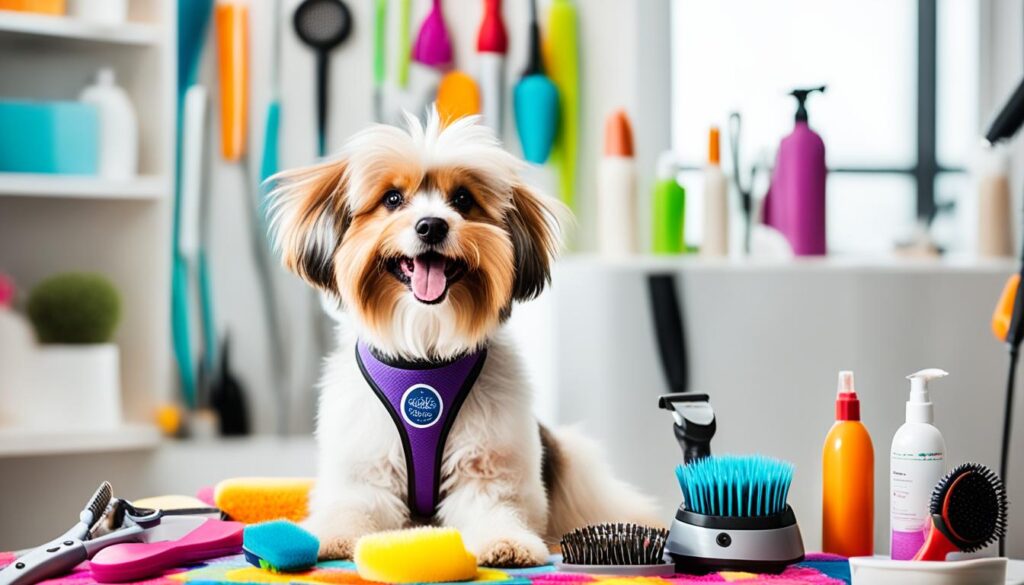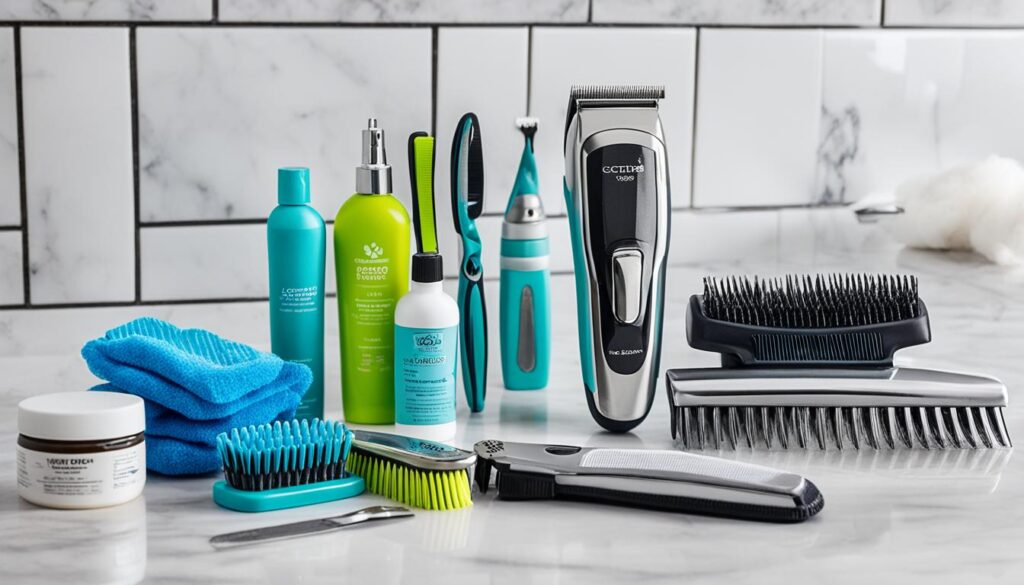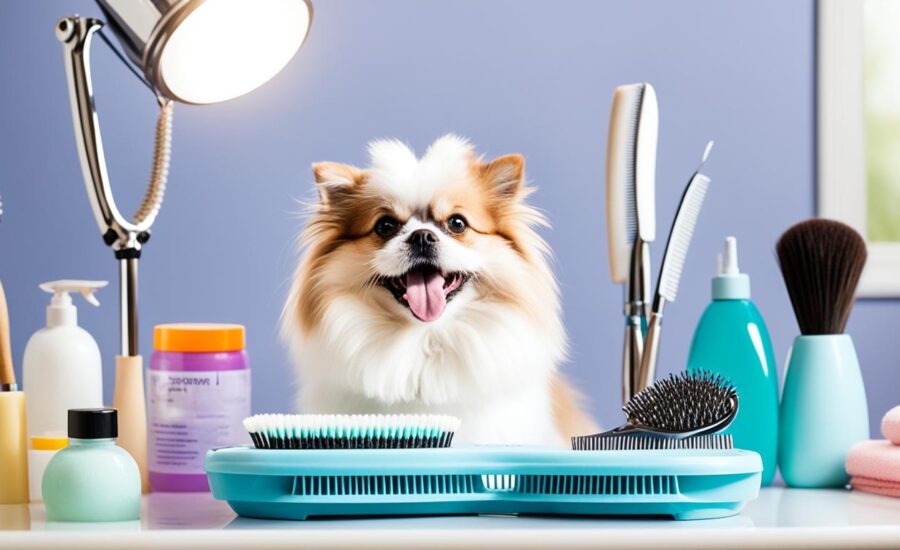Many pet owners depend on pros to make their furry friends look great. But, the real secret to keeping your pet healthy and happy might be closer than you think. Ever thought about grooming your pet yourself between those pro sessions? By learning DIY grooming tricks, you can play a big part in your pet’s well-being.
Doing regular grooming at home does more than keep your pet’s coat shiny. It also builds special moments between you and your pet. Let’s explore how grooming at home can benefit your four-legged friends.
Key Takeaways
- Understand the importance of regular pet grooming for overall health and well-being.
- Learn how DIY pet grooming routines can strengthen the bond between you and your pet.
- Discover the essential tools and techniques for pet grooming at home.
- Explore expert tips on maintaining your pet’s coat between professional grooming sessions.
- Identify ways to ease your pet into a grooming schedule that works for both of you.
- Gain insights on how at-home grooming can help in early detection of potential health issues.
The Essential Role of Home Grooming in Pet Health and Bonding
Home grooming keeps pets looking good and helps their health and mood. It adds to pro care and strengthens pet-owner bonds. It’s key for keeping a pet’s coat good, happy, and comfy.
Understanding the Benefits beyond Appearance
Home grooming does more than make pets look nice. Regular brushing stops painful matting and too much shedding. It also spreads their natural skin oils, making their coat and skin healthy.
Grooming as an Opportunity for Early Detection of Health Issues
Grooming lets owners spot early health signs. They can look for bumps, lumps, or pests like fleas and ticks. This way, they can quickly deal with these issues before they get worse.
Strengthening Bonds through Regular Grooming Routines
Grooming often helps build a strong bond. This calm time together builds trust and helps pets feel less scared. Doing it regularly makes pets feel safe and loved.
Grooming is about more than a neat coat. It enhances pets’ physical and emotional health. Every brush stroke strengthens the bond of care and friendship between owners and their pets.
How to Groom Your Pet Between Professional Sessions
Starting the DIY pet grooming journey strengthens your connection with your pet. It also keeps them healthy. Before you start grooming your pet at home, know that the right grooming tools for pets are key. The tools you need depend on your pet’s coat type and size. They help make grooming at home successful and stress-free.

A regular pet grooming at home routine makes your pet look better and boosts their health. It helps by removing dirt and preventing fur tangles. DIY grooming requires patience, especially with nail trimming and fixing fur mats. It’s a way to ensure your pet is looking good and staying healthy.
| Grooming Task | Tools Needed | Tips for Safety and Comfort |
|---|---|---|
| Brushing | Brushes, combs | Choose a brush suited to your pet’s coat type to remove loose fur and prevent tangles. |
| Nail Trimming | Nail clippers, styptic powder | Clip nails cautiously to avoid the quick, have styptic powder ready for accidents. |
| Ear and Eye Cleaning | Pet-safe cleansers | Use specially-formulated cleansers and gently wipe away debris. |
| Bathing | Mild pet shampoo, towels | Use a gentle shampoo and thoroughly rinse and dry to prevent skin issues. |
| Mat and Tangle Removal | Detangling sprays, dematting tools | Work slowly with the appropriate tools, never pull or cut without caution. |
| Health Monitoring | Your observation | Keep an eye out for parasites, infections, or any changes in your pet’s skin or coat. |
Positive reinforcement works wonders; combine treats and praise with grooming. This makes it enjoyable for your pet. A regular schedule creates a safe routine. It also allows for close moments to
inspect your pet’s health, from paw pads to ear tips, ensuring they are both happy and thriving.
With the right tools and approach,
DIY pet grooming
becomes a valuable experience. It strengthens your bond and keeps your pet in top shape.
Choosing the Right Grooming Tools for Your Pet
For many pet owners, pet grooming at home is important for looks and health. There are many grooming tools for pets to choose from. You need the right ones for your pet’s breed and coat. Good at-home grooming techniques make the process calm and enjoyable for you and your pet.
Let’s look at the best tools and how to use them. This way, you can put together a great home grooming kit:
- Slicker Brushes: Ideal for untangling and smoothing medium to long-haired dogs
- Bristle Brushes: Perfect for short-haired breeds to get rid of loose fur and dirt
- Combs: Important for detailed grooming, especially around the face and ears to prevent mats
Chatting with a professional groomer can help you pick the right tools for your pet. Below, find some suggested tools:
| Breed Type | Recommended Brush | Recommended Comb |
|---|---|---|
| Medium to Long-Haired Dogs | Slicker Brush | Wide-Toothed Comb |
| Short-Haired Dogs | Bristle Brush | Fine-Toothed Comb |
| Cats | Pin Brush | Metal Comb |
The right tools matter, but how you use them is just as important. Use gentle strokes and be patient. It makes grooming a nice experience. Slowly get your pet used to new tools to keep things calm. This builds trust and helps your pet enjoy grooming as bonding time.

Knowing at-home grooming techniques and getting the right grooming tools for pets will keep your pet’s coat in great shape. This helps a lot between visits to a professional groomer.
Establishing a Consistent Grooming Routine at Home
Setting up an at-home grooming routine is crucial for your pet’s wellbeing. It helps keep their coat healthy and makes grooming stress-free for both of you. Regular grooming sessions also strengthen the bond between you and your pet. They transform a chore into a chance for connection. Aim for each session to be thorough but not too much for your pet.
Creating a Schedule for Grooming Tasks
Starting a pet grooming routine means planning a calm environment. Pick days for brushing or bathing and stay consistent. Long-haired pets might need daily brushing to prevent tangles. Short-haired ones might only need it a few times a week. The key is to stick with your plan but adjust as needed for your pet’s needs.
Easing Your Pet into the Grooming Process
Introduce at-home grooming techniques slowly so your pet gets used to them. Start with short grooming times and gradually do more, being kind and calming. Use treats and praise to link grooming with happy times. Soon, grooming will become a peaceful time you both enjoy.
Using Positive Reinforcement to Build Trust
Positive reinforcement is great for building trust during grooming. Reward your pet for being calm with treats and love. This shows them grooming is good. As you care for their coat, watch how they react. Adjust to keep them comfortable. Paying attention to their needs helps grow a loving and trusting relationship.
FAQ
What are the benefits of regular home grooming for my pet’s appearance and health?
How often should I groom my pet at home between professional grooming sessions?
Can home grooming help with early detection of health issues?
Why is it important to bond with my pet during grooming sessions?
What kind of grooming tools should I use for my pet?
How can I establish a consistent grooming routine at home?
What are some tips for making the grooming experience more comfortable for my pet?
How can I effectively handle mats and tangles in my pet’s coat?
Can home grooming prevent parasites like fleas and ticks?
How do I safely trim my pet’s nails during at-home grooming sessions?
Source Links
- https://collarcuts.com/9-pet-grooming-tips-from-the-pros/
- https://www.petbarinc.com/pet-care-tips-grooming-between-appointments/
- https://skiptown.io/maintaining-your-dogs-coat-between-grooms-tips-from-professional-dog-groomers/

